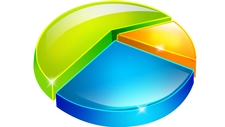Types of Graphs

TEKS Objective
The student is expected to construct maps, graphic organizers, simple tables, charts, and bar graphs using tools and current technology to organize, examine, and evaluate measured data.
Essential Understanding
The student uses scientific inquiry methods during laboratory and outdoor investigations.
Science Background
Using Graphs and Visual Data: Visionlearning (website) - Detailed information about the use and importance of visual representations (i.e., graphs and figures) for data analysis and interpretation. Includes references for further reading and additional learning modules.
Using Graphs and Visual Data
Visionlearning, www.visionlearning.com
Data and Graphs: Ligonier Valley School District (PowerPoint) – This slide show gives examples of different types of commonly used graphs and explains which kind of data can be used for each graph type.
Data and Graphs
Ligonier Valley School District, www.lvmsmath6.wikispaces.com
Representing Data, Introduction: KS3 Bitesize/BBC (website) - Links to information on creating and understanding different types of graphs or charts used to organize and represent scientific data: bar charts, line graphs, pictograms, pie charts, frequency diagrams and scatter diagrams.
Representing Data, Introduction
KS3 Bitesize/BBC, www.bbc.co.uk
Signature Lesson
Creating a Bar Graph: My NASA Data/NASA (website) - Simple lesson that uses authentic NASA data to teach students basic bar graph construction.
Creating a Bar Graph
My NASA Data/NASA, mynasadata.larc.nasa.gov
- Supporting Lessons
- Extensions
- Assessment Ideas
- Literature Connections
- Related
TEKS - Additional Resources
Supporting Lessons
Bar Graphs: Teachers.net (website) – Students line up by the month of their birthdays to create a human bar graph. Then, the class makes another bar chart displaying their favorite breakfast cereals.
Elaboration Lessons and Extensions
The Daily Ups and Downs: How To Smile (website) – Students elaborate on the monthly temperature bar chart by creating a daily temperature line graph, learning the difference between and bar and line graph in the process.
Assessment Ideas
Assess your students by giving them a set of data, complete with different categories/variables, and having them create an appropriately labeled and titled bar chart.
Create a Bar Graph: National Center for Educational Statistics (website) – Students can use this online tool to create bar charts after they have correctly organized their data. There is also an example data set included on the page.
Create a Bar Graph
National Center for Educational Statistics, nces.ed.gov
Literature Connections
Great Tables, Graphs, Charts, Diagrams & Timelines You Can Make. Zike, Dinah (ISBN-13: 978-1882796144)
Beginning Charts, Graphs & Diagrams. Carratello, Patty (ISBN-13: 978-1557341686)
Additional Resources
How to Make a Graph and Chart Made Easy: Easy-Science-Fair-Projects.net (website) - Step-by-step explanation of how to organize information using graphs and charts.
How to Make a Graph and Chart Made Easy
Easy-Science-Fair-Projects.net
TEKS Navigation
Grade 3
Need Assistance?
If you need help or have a question please use the links below to help resolve your problem.

Comments